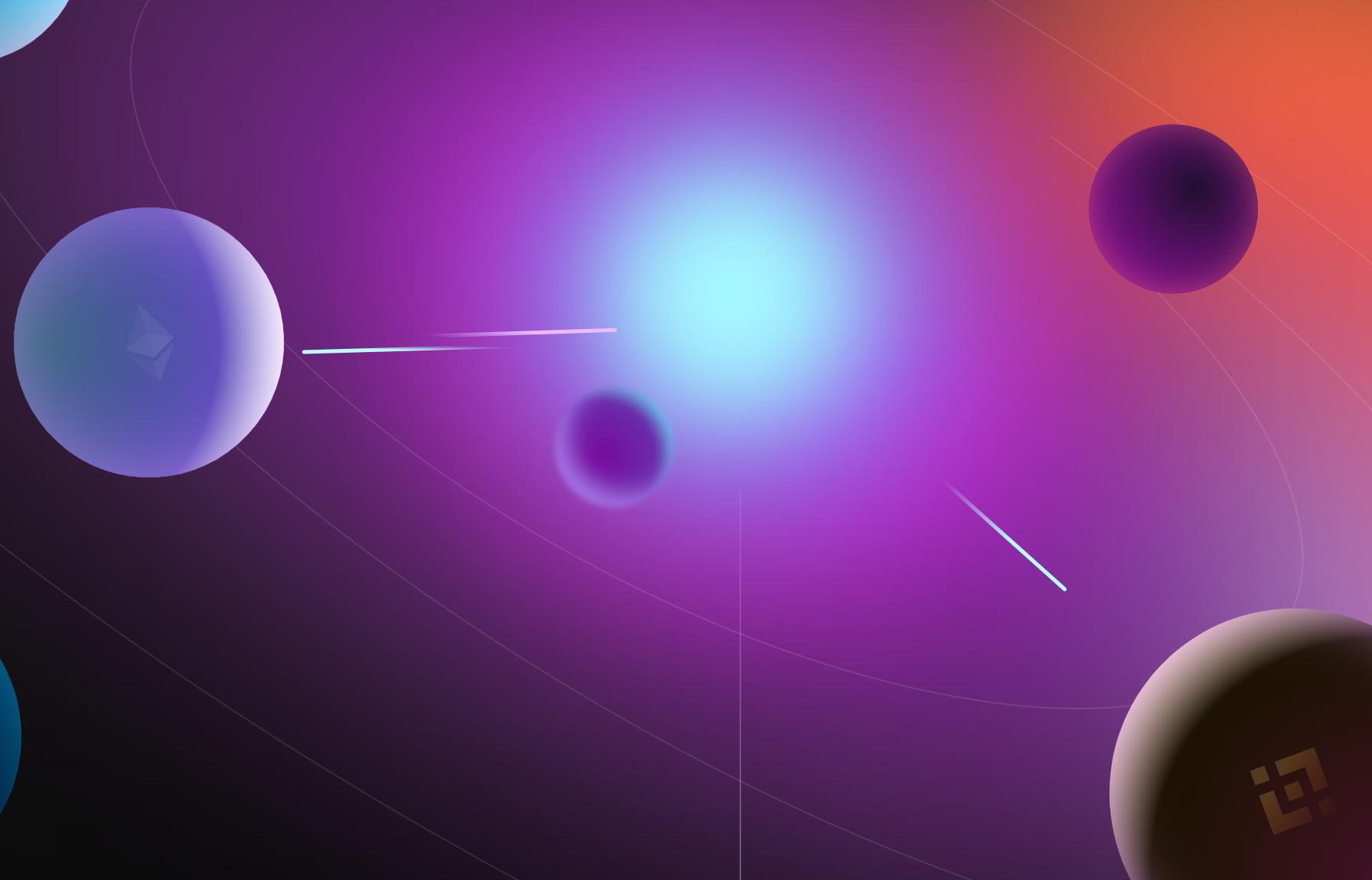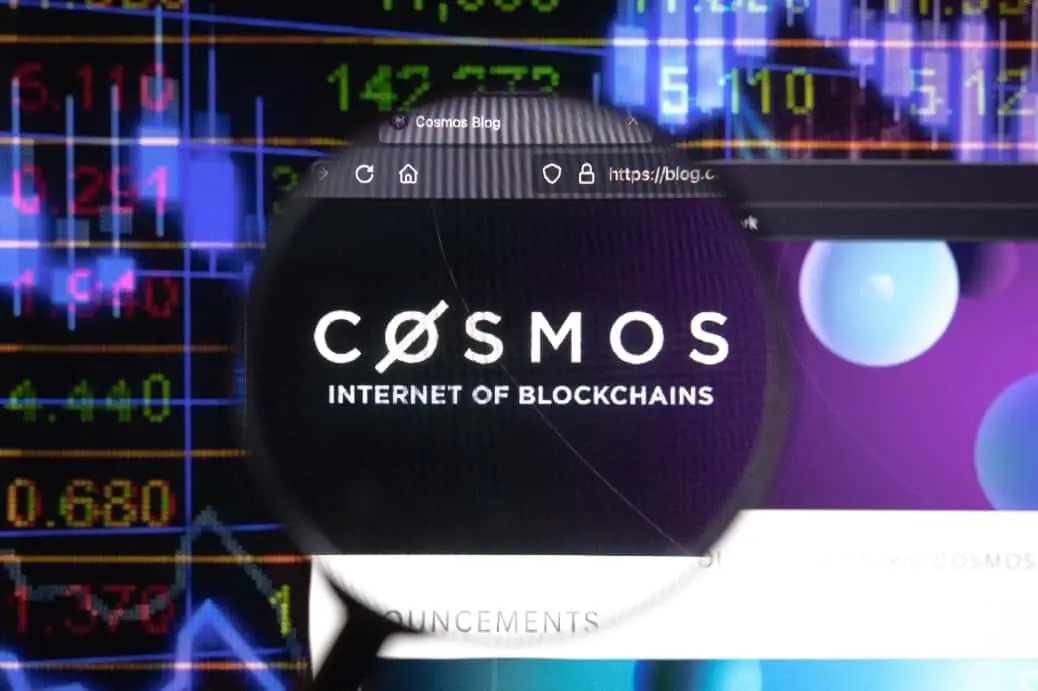A detailed explanation of how Cosmos operates: How do application chains, zone chains, and hub chains function?
Author: Alex Gedevani, Medio Demarco
Original Title: 《The Cosmos Ecosystem Has Arrived》
Compiled by: Hu Tao, Chain Catcher
The competition among various Layer 1s has never been so fierce. As more and more applications go live and liquidity deepens within their respective ecosystems, the value of tokens from Ethereum, Solana, Avalanche, and other companies continues to appreciate. Cosmos is a promising ecosystem that has made significant progress over the past year, but it is often misunderstood. Why? Well, simply put, Cosmos is built differently.
To understand how, let’s start with a basic comparison to Ethereum. As a general-purpose blockchain, different types of applications are built directly on Ethereum. They all share the same security and compete for the same block space. This has its advantages, such as composability and strong security guarantees, but it also has downsides, such as high fees caused by network congestion.
In contrast, Cosmos is not a single blockchain where all applications exist. Instead, it is an ecosystem made up of many blockchains, each optimized for its specific application. Historically, one of the main factors hindering the Cosmos ecosystem has been the simple fact that these "app chains" cannot communicate with each other, leading to a lack of composability between applications, which has played a crucial role in Ethereum's success.
However, it is important to note that this is no longer the case since the launch of the Inter-Blockchain Communication protocol (also known as "IBC"). Although IBC was launched in February 2021, it has not yet been implemented across all major app chains. As such an important new technology, the hesitation from development teams has mainly focused on wanting to see it operate as expected in a natural environment for a while before integrating it. But this is finally starting to change, and the Cosmos ecosystem seems to be flourishing as a result.
In this report, we will introduce you to how Cosmos works, analyze its appeal so far, and speculate on its future. Before we dive into more complex issues, let’s first clearly outline some key terms you will see repeatedly throughout this article.
- App-Chain: An independent blockchain optimized for a specific use case/application. They are built using the Cosmos SDK, allowing developers to plug in various modules (such as IBC) with different functionalities when building a blockchain. Without shared staking (which we will discuss later in this article), app chains have their own sovereignty and security assumptions.
- Zone: An app chain or independent non-Cosmos chain that has established IBC integration. The IBC module communicates with each other by sending packets through channels.
- Hub: In the most basic sense, a hub is a zone that connects many channels, allowing it to facilitate IBC between them. While theoretically any zone can act as a hub, this term is most commonly used in the context of the Cosmos Hub. We will revisit the implications of this later in the post.
With these terms in mind, let’s navigate through each component with diagrams that illustrate how the various parts fit together. Let’s start with one of the most important building blocks, the Cosmos SDK, and how it is used to create app chains, as shown below.
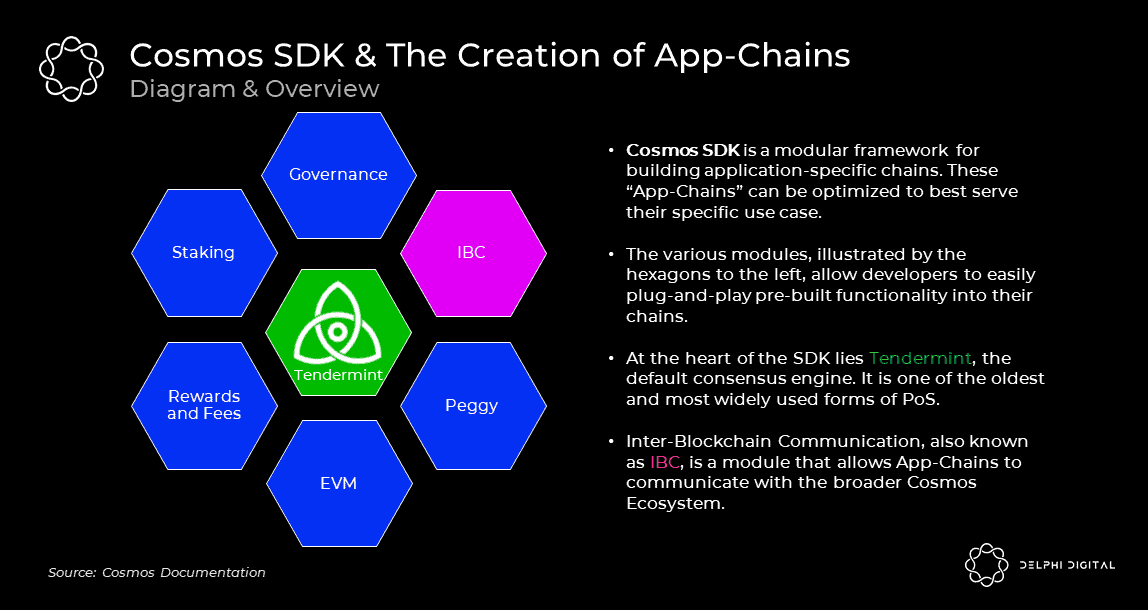
It is easy to underestimate the number of blockchains that have been built using the Cosmos SDK. If you visit cosmos-cap.com, you will certainly notice some recognizable names. Over time, we expect the proliferation of app chains to increase, especially as new modules are added to the SDK and existing modules are strengthened/improved. At the time of writing, the total market capitalization of all Cosmos-based blockchains is approximately $110 billion.
Now, a single app chain is useful on its own, but its full potential is not truly unlocked until it connects to the broader Cosmos ecosystem. In the diagram below, we describe how this ecosystem comes together. At the center is the Cosmos Hub, an app chain where validators stake the native token ATOM of Cosmos. The Cosmos Hub area in the diagram consists of three different rings, which we use to illustrate the three different use cases it supports—1) IBC, 2) Gravity DEX, and 3) Shared Staking. For our explanation, we will start from the outer ring, IBC, and then gradually introduce the others.
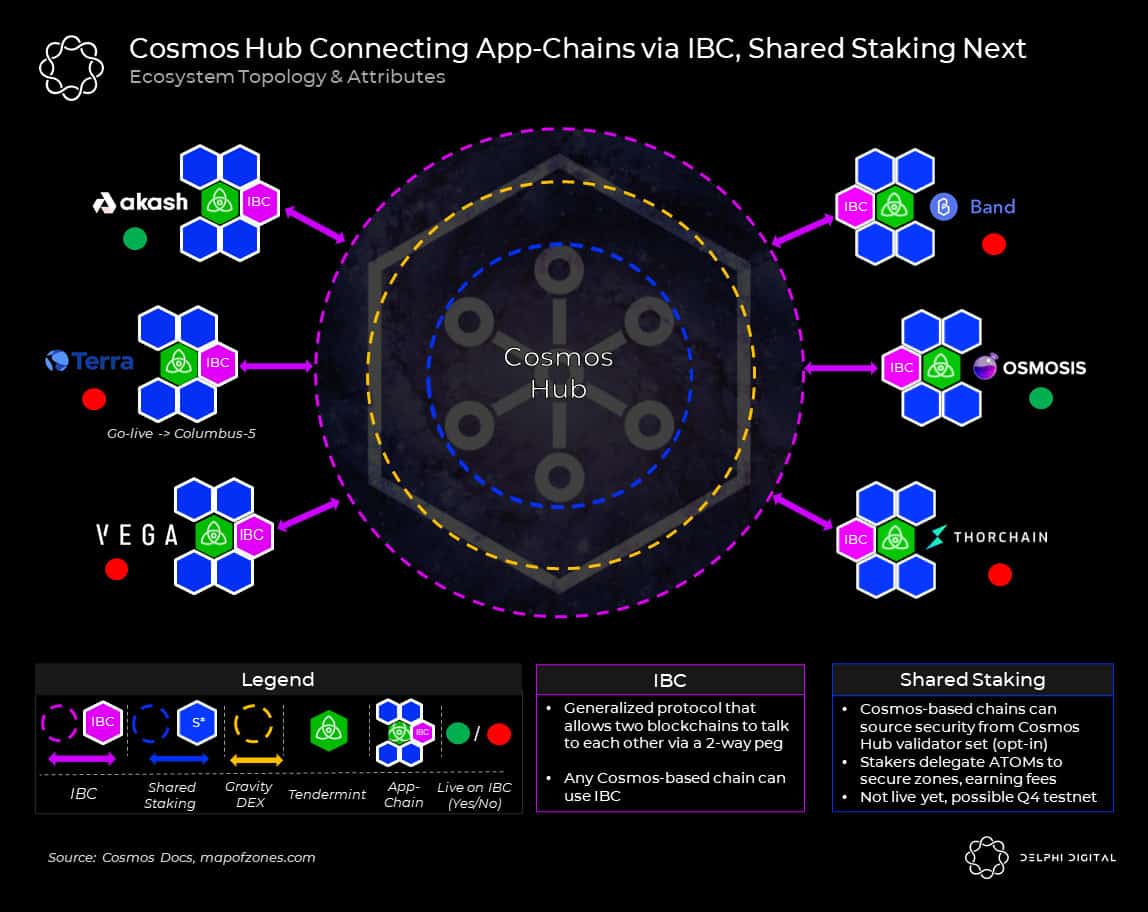
If you recall the previous definitions, then app chains that implement the IBC module will subsequently be classified as zones. Now, imagine a zone that opens communication channels with all other zones. What we just described is essentially a hub. It can be imagined that if there are hundreds or thousands of zones outside, having each zone directly connect to each other would be cumbersome, resource-intensive, and potentially inefficient.
In contrast to this approach, if a zone simply opens a communication channel with the hub, it has effectively done all the heavy lifting from a network perspective, allowing it to easily interoperate with all other zones connected to that hub. This is why Cosmos uses a "hub-and-spoke" model, which can be seen in the map of zones in the diagram below. Note the two zones we have highlighted below, which we will detail later.
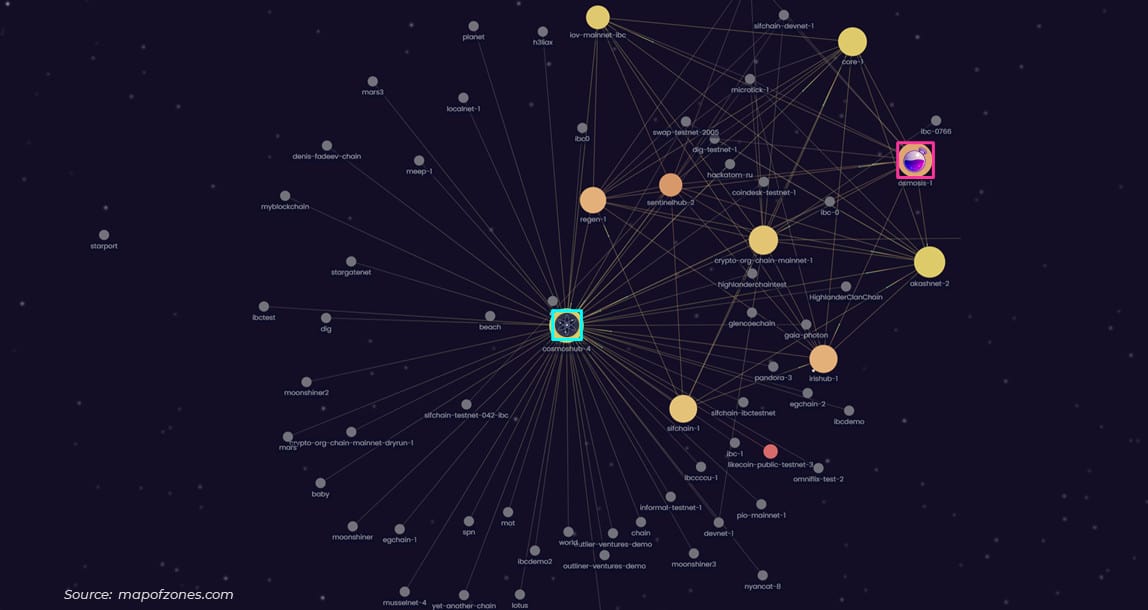
Once interoperability is established, liquidity begins to flow. Where liquidity flows, decentralized exchanges have the opportunity to capitalize on it. Since this is Cosmos, that DEX application will be its own blockchain. This brings us to Osmosis, the first IBC-native DEX in Cosmos.
We previously wrote about this topic in the THORChain report. In that article, we highlighted how cross-chain DEXs provide meaningful utility and generate considerable value. Although THORChain is built using the Cosmos SDK, the ATOM token does not directly benefit from its use. We may not be the first or the last to raise this criticism of the ATOM token.
Interestingly, the Cosmos development team recently decided to build an exchange directly into The Cosmos Hub—Gravity DEX—which may frustrate the Osmosis development team. While Gravity DEX enhances the value accumulation of the ATOM token, it does indeed undermine the claim of Cosmos Hub's credible neutrality. Before we proceed, it is worth noting that the main difference between Osmosis/Gravity DEX and THORChain is that the latter focuses on facilitating trades between non-Cosmos-based chains (such as Bitcoin and Ethereum), while the former focuses specifically on the Cosmos ecosystem, at least at this stage.
The last blue ring in the diagram represents Shared Staking (Interchain Security). Historically, we have seen app chains self-organizing their validator sets. For new chains starting with lower token prices, this can be challenging due to weaker security at that stage. However, what if new applications could shift this resource-intensive work to external parties and instead focus on building their core products? You know, like on Ethereum. We would see new applications connected through IBC and a richer ecosystem come to market faster.
This is where shared security comes into play. It places validators from the Cosmos Hub at the forefront, allowing them to lease security to multiple opt-in app chains at a certain price. This is an attractive proposition for validators as they can earn more fees by supporting multiple "sub-chains" rather than just staking the Cosmos Hub (i.e., the "parent chain").
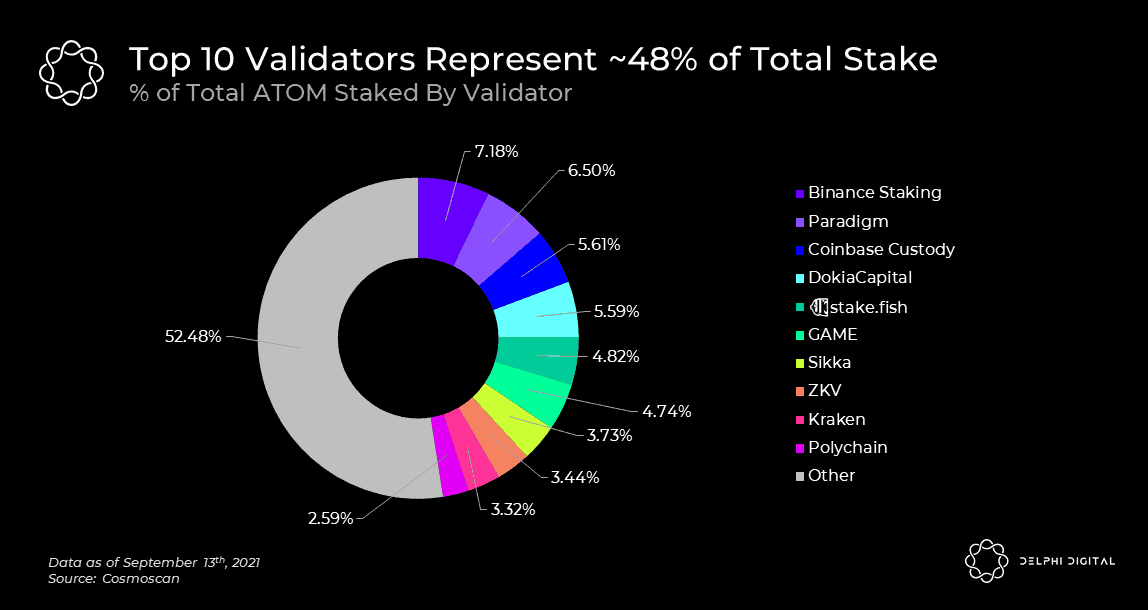
With shared staking still fresh in your mind, let’s shift our focus and assess the current state of the Cosmos Hub validator set (i.e., ATOM stakers). As shown in the diagram above, the top 10 validators account for 48% of all ATOM staked. For context, the current total number of validators is 144.
Importantly, the Cosmos Hub implements DPoS, which means passive ATOM holders can delegate their staked tokens to active validators in exchange for a share of the rewards. The exact amount of shared income varies by validator. The larger the share of income, the more delegators a validator should logically have.
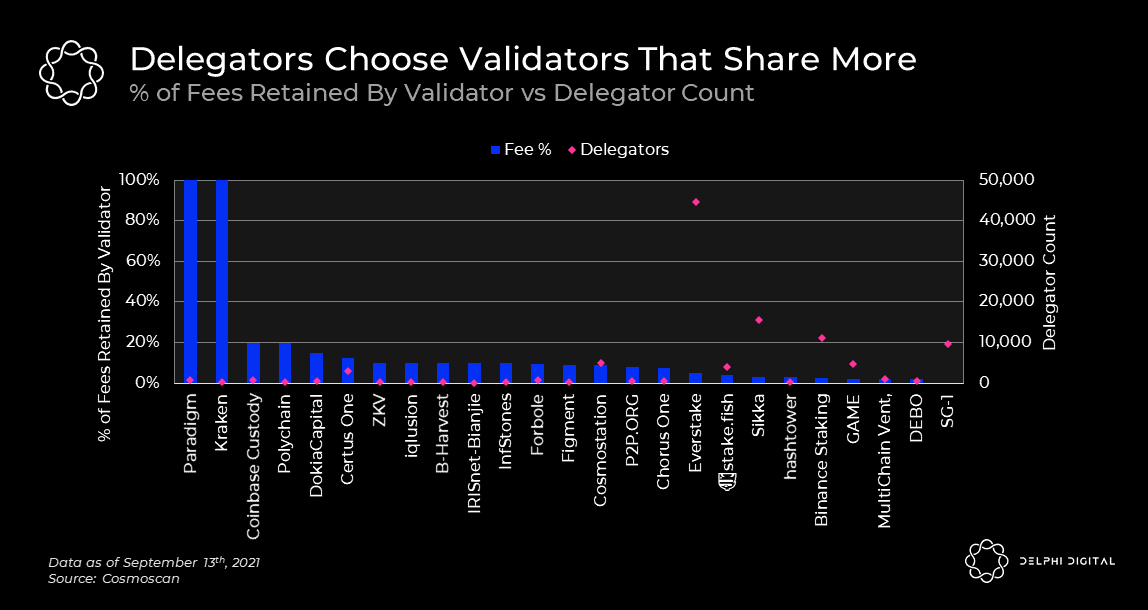
ATOM stakers earn returns from two main sources—1) new ATOM issuance and 2) transaction fees from The Cosmos Hub. Regarding the first point, the current annual inflation rate of ATOM is approximately 7%. As for the latter, fees can come from several different sources. As we mentioned earlier, the Cosmos Hub supports IBC, Gravity DEX, and Shared Staking, all of which can generate fees. Since IBC is the only one of these sources that is fully operational, let’s quickly review its recent activity.
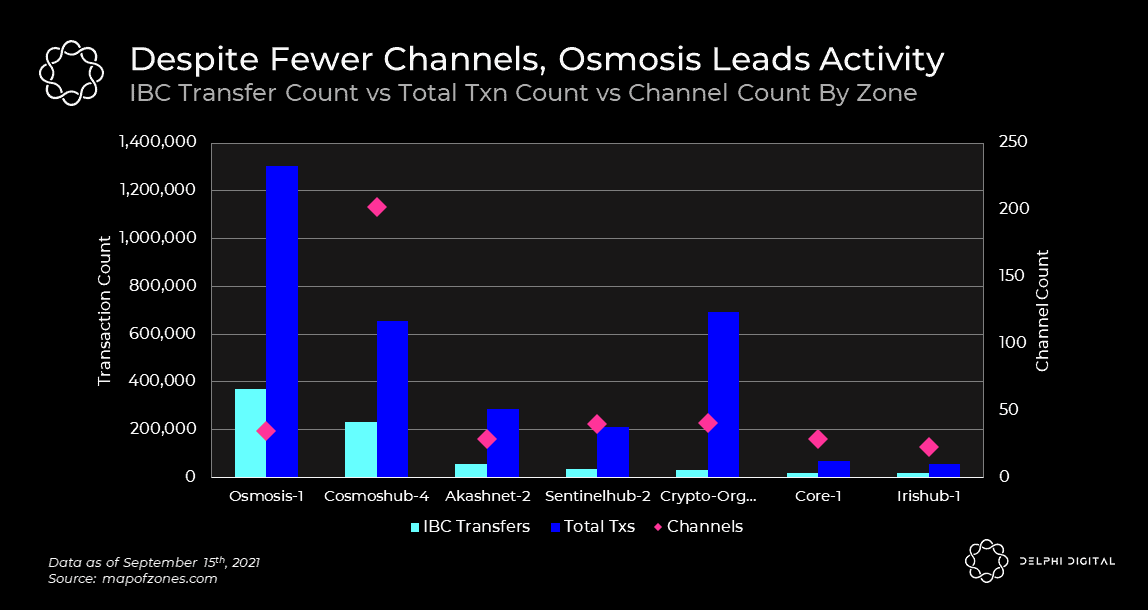
Earlier in this report, we outlined how zones open communication channels with each other to facilitate IBC transactions. The more channels that are opened, the more transactions can potentially occur. Given this context, it may be surprising to see that the Cosmos Hub significantly leads in total channel count, with fewer IBC transfers than Osmosis. Let’s explore this further.
Osmosis launched on June 19, 2021, with a listing strategy focused on attracting native IBC assets into its liquidity pools. Osmosis is not a typical one-size-fits-all AMM. It offers customizability, such as supporting different price curves and autonomous liquidity pools. It supports LBP, similar to Balancer, which may be attractive for new projects launching in Cosmos. The development team is also exploring super liquidity staking, which would allow Osmosis LPs to delegate their LP tokens to validators. This would enable them to earn both liquidity mining rewards and staking rewards simultaneously.
On a technical level, the main difference between Gravity DEX and Osmosis lies in its hybrid order book design. How/if Gravity DEX will provide liquidity mining incentives similar to Osmosis remains to be seen. The primary goal of Gravity DEX is that it is built directly on the Cosmos Hub, positioning it to benefit directly from the ongoing adoption of IBC.
Osmosis's liquidity is entirely built using IBC, without CEX support. This means that to purchase OSMO, traders must use one of the OSMO trading pairs on the DEX itself, such as ATOM/OSMO. The ATOM/OSMO pool continues to have the deepest liquidity, accounting for 37% of the total TVL.
Conclusion
Let’s revisit this graphic.

At the center, we have the blue-highlighted Cosmos hub chain, and to the right, we have the pink Osmosis zone chain. Recall that any zone, if it has enough channels connected to it, can be considered a hub. This raises the question ------Is the Cosmos ecosystem centered around one large hub chain, or will there be several large hub chains?
We lean towards the latter, as it has already been established between Osmosis and The Cosmos Hub. Both can facilitate IBC and both have built-in native DEXs. The main distinction of the Cosmos Hub is that it plans to offer shared staking in the future, which is unique and could ultimately become a wildcard for ATOM value accumulation.
Is Cosmos a Layer 1 blockchain? Technically, yes, the Cosmos Hub is a blockchain. But unlike other major Layer 1s (Ethereum, Solana, etc.), Cosmos must compete with applications within its own ecosystem, at least for now compared to other DEXs. Even if the Cosmos Hub itself does not maintain persistence, the Cosmos ecosystem may continue to grow and thrive, albeit with less likelihood. This scenario is simply not possible on other networks. Of course, the more app chains there are, the more activity there will be in the Cosmos ecosystem, from which ATOM stakers can benefit.
The Cosmos Hub is an app chain. To thrive, it needs to find its killer application. Perhaps that is shared staking, perhaps it is Gravity DEX, or maybe it is just the best IBC hub out there.



